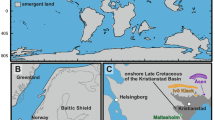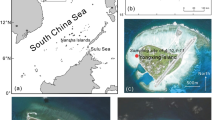Abstract
Seasonality is one of the most dramatic climatic variables affecting the physical and biological properties of the surface of oceans. Attempts to deduce the seasonal temperature contrast of past oceans using the fossil record have led investigators to explore the carbonate growth patterns in certain marine invertebrate organisms. In many cases these growth patterns represent annual growth increments analogous to annual rings in trees1. Just as tree rings contain a record of terrestrial climates2, systematic variations in the physical or chemical properties of annual growth increments in the skeletons of marine organisms record the environmental or climatic properties of the marine realm. Several investigations have called attention to the use of stable isotope profiles in growth increments of mollusc shells to determine the seasonal water temperature changes3–7 and seasonal timing of coastal upwelling8. Mollusc shells therefore have the potential of revealing much information about past environmental changes9, particularly along temperate continental shelves where our knowledge of the palaeoceanographic history is very limited. We have now used coordinated isotopic and sclerochronological (growth increment) studies to compare the geochemical history of shell growth in Spisula solidissima with the physical oceanographic history of the Middle Atlantic Bight and determine whether the isotopic records of S. solidissima from different water depths on the continental shelf reflected the seasonally different thermal regimes at those depths. We chose S. solidissima because it is widely distributed along temperate continental shelves, its shell growth and life history are well understood9,10, and the genus has a fairly wide distribution in Plio–Pleistocene fossil deposits. Jones11,12 has already established through a detailed sclerochronological analysis of S. solidissima that a 10–20 yr time series of mean sea surface temperature trends can be resolved from the record of annual shell growth. A strong negative correlation exists between growth increment size and yearly mean water temperature11.
This is a preview of subscription content, access via your institution
Access options
Subscribe to this journal
Receive 51 print issues and online access
$199.00 per year
only $3.90 per issue
Buy this article
- Purchase on Springer Link
- Instant access to full article PDF
Prices may be subject to local taxes which are calculated during checkout
Similar content being viewed by others
References
Rhoads, D. C. & Lutz, R. A. (eds) Skeletal Growth of Aquatic Organisms (Plenum, New York, 1980).
Fritts, H. C. Tree Rings and Climate (Academic, New York, 1976).
Epstein, S. & Lowenstam, H. A. J. Geol. 61, 424–438 (1953).
Emiliani, C. & Mayeda, T. Am. J. Sci. 262, 107 (1964).
Shackleton, N. J. Archaeometry 15, 133–141 (1973).
Killingley, J. S. Am. Ant. 48, 152–158 (1981).
Tourtelot, H. A. & Rye, R. O. Bull. geol. Soc. Am. 80, 1903–1922 (1969).
Killingley, J. S. & Berger, W. H. Science 205, 186–188 (1979).
Rye, D. & Sommer, M. A. in Skeletal Growth of Aquatic Organisms (eds Rhoads, D. C. & Lutz, R. A) (Plenum, New York, 1980).
Jones, D. S., Thompson, I. & Ambrose, W. G. Mar. Biol. 47, 63–70 (1978).
Ropes, J. W. U.S. natn. Mar. Fish. Serv. Northeast Fish. Cent. tech. Ser. Rep. 24, 1–88 (1980).
Jones, D. S. Science 211, 165–167 (1981).
Jones, D. S. thesis, Princeton Univ. (1980).
Caddy, J. F. & Billard, A. R. Tech. Rep. mar. envir. Data Ser. Can. 648, 1 (1976).
Williams, D. F., Sommer, M. A. & Bender, M. L. Earth planet. Sci. Lett. 36, 391–403 (1977).
Epstein, S., Buchsbaum, R., Lowenstam, H. A. & Urey, H. C. Bull. geol. Soc. Am. 64, 1315–1326 (1953).
Bowman, M. J. MESA N.Y. Bight Atlas 1, 1–78 (1977).
Colton, J. R. & Stoddard, R. R. Tech. Rep. NMFS CIRC-376, 1–55 (1973).
Jones, D. S. Paleobiology 6, 331–340 (1980).
Jones, D. S., Williams, D. F. & Arthur, M. A. EOS 62, 296 (1981).
Author information
Authors and Affiliations
Rights and permissions
About this article
Cite this article
Williams, D., Arthur, M., Jones, D. et al. Seasonality and mean annual sea surface temperatures from isotopic and sclerochronological records. Nature 296, 432–434 (1982). https://doi.org/10.1038/296432a0
Received:
Accepted:
Issue Date:
DOI: https://doi.org/10.1038/296432a0
This article is cited by
-
Lifespan and growth of Astarte borealis (Bivalvia) from Kandalaksha Gulf, White Sea, Russia
Polar Biology (2018)
-
Advances in mollusc sclerochronology and sclerochemistry: tools for understanding climate and environment
Geo-Marine Letters (2008)
-
The curse of physiology—challenges and opportunities in the interpretation of geochemical data from mollusk shells
Geo-Marine Letters (2008)
-
Correlation of stable oxygen isotope temperature record with light attenuation profiles in reef-dwellingTridacna shells
Coral Reefs (1991)
Comments
By submitting a comment you agree to abide by our Terms and Community Guidelines. If you find something abusive or that does not comply with our terms or guidelines please flag it as inappropriate.



